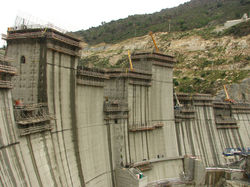CARLOS SERRA
Civil engineer / Ph. D. candidate
Ph. D. PROPOSAL
Dam concrete material characterization
Experimental and numerical study
Water supply, flood control and sustainable energy production are of great importance for both developed and under development countries. Maintenance and rehabilitation issues of existing structures and important new investments in dam construction require technological advances for more efficient, sustainable and safe structures.
Dam concrete experimental characterization has particular challenges. The use of large aggregate maximum size implies the use of large specimens. Is common to remove the larger aggregates, cast smaller specimens and embed monitoring devices with the remaining wet-screened concrete. Although it has similar properties, the need for reliable relationships is essential for concrete quality control during construction, safety control and monitoring data analysis throughout service life.
In this project is intended to correlate the rheological properties of dam concrete placed in situ and of wet-screened concrete using experimental results from a concrete dam and numerical simulation using rigid particle models.
Dam concrete
The rheological properties of dam concrete are different from the conventional and the wet-screened concrete, both for instantaneous behaviour and time-dependent behaviour.
As a result of its specific use, studies involving dam concrete are sparse and locally significant, therefore, due to the strategic importance of these structures, deeper developments are needed.
Experimental work
Experimental testing of the produced concrete carried out for quality control and for properties characterization, is a key element for this type of structures.
The complexity of concrete response, from viscoelastic to fracture behaviour, implies different tests to determine the instantaneous, both in tension and compression, and time-dependent behaviour of wet-screened and full-mixed concrete.
Usually, the instantaneous behaviour is characterized by modulus of elasticity determination tests, tensile and compression strength determination tests carried out at several ages. The time-dependent behaviour is evaluated from in situ and laboratory compression creep tests using different loading ages.


 |
|---|
 |
 |
 |
 |
 |
Numerical study
Numerical modelling of concrete behaviour can be of great use. This work aims to develop concrete numerical particle models to investigate properties correlation between wet-screened mortar (paste and aggregate), #38 wet-screened concrete (used for laboratory tests and to embed monitoring devices) and full-mixed concrete (used in the dam body).
When validated with experimental tests, numerical models are suitable to estimate mechanical properties of full-mixed concrete based on wet-screened laboratory test results, reducing the number specimens necessary to characterize the mass concrete properties and improving the interpretation of in situ monitored data over time, for different loadings and environmental conditions.

General approach for the Ph.D. proposal
